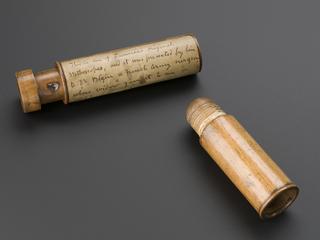
Glass negative of electrocardiograph trace, 1915-1925




Glass negative of ECG trace thought to be from ECG machine by the Cambridge Instrument Co.
Electrocardiograms are visual representations of heart activity. They are known as ECGs. They were recorded photographically until the 1950s. This is an early glass plate negative showing the electrical activity of the heart. It was produced in conjunction with a machine called a galvanometer. A galvanometer measures small electric currents such as the heart beat. Electrodes placed on the body pick up minute electrical impulses. These cause a string within the galvanometer to move. Movement was then recorded photographically to make the electrocardiogram. Physicians examine the records for irregularities that may be a sign of disease.
Details
- Category:
- Clinical Diagnosis
- Object Number:
- 1980-1213 Pt3
- Materials:
- glass
- Measurements:
-
overall: 85 mm x 170 mm .06kg
- type:
- glass negative




